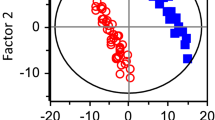Abstract
The sera of 51 patients with malignant (n=25) and benign (n=26) hepatopancreatobiliary disorders were analysed by1H magnetic resonance spectroscopy (NMR) in order to distinguish between malignant and benign diseases causing jaundice and/or cholestasis. Macromolecular linewidths were determined both manually and automatically with a computed analysis, and both methylene (CH2) and methyl (CH3) resonances were evaluated. The mean linewidth of the CH3 peak was significantly narrower in the patients with malignant disease than in the patients with benign disease both in the manual and computed analyses, but no significant differences in the CH2 peak were detected. Diagnostic sensitivity and specificity of the CH3 peak determined in the computed analysis were 92% and 27% respectively. In the light of the current study, it seems obvious that because overlap between benign and malignant groups was too great,1H NMR spectroscopy of plasma is not of practical value in distinguishing between benign and malignant causes of jaundice and/or cholestasis.
Similar content being viewed by others
References
Berger S, Pfluger KH, Etzel WA, Fischer J (1989) Detection of tumours with nuclear magnetic resonance spectroscopy of plasma. Eur J Cancer Clin Oncol 25:535–543
Campbell EE, Gabriel DA (1990) A, letter to the Editor. N Engl J Med 323:679
Dowd TL, Kaplan BA, Gupta RK, Aisen P (1987) Detection of malignant tumors: water-suppressed proton nuclear magnetic resonance spectroscopy of plasma. Magn Reson Med 5:395–397
Engan T, Krane J, Klepp K, Kvinnsland S (1990) Proton nuclear, magnetic resonance spectroscopy of plasma, from healthy subjects and patients with cancer. N Engl J Med 322:949–953
Fossel ET (1989) Effect of triglyceride levels on methyl and methylene envelope line widths in proton nuclear magnetic resonance spectroscopy of human plasma. N Engl J Med 321:1409–1410
Fossel ET, Carr JM, McDonagh J (1986) Detection of malignant tumors. Water-suppressed proton nuclear magnetic resonance spectroscopy of plasma. N Engl J Med 315:1369–1376
Hiltunen Y, Ala-Korpela M, Jokisaari J, Eskelinen S, Kiviniitty K, Savolainen M, Kesäniemi YA (1991) A lineshape fitting model for1H NMR spectra of human blood plasma. Magn Reson Med 21:222–232
Hofeler H, Scheulen ME (1989) Monitoring of patients with nonoseminomatous testicular cancer by magnetic resonance spectroscopy of plasma. Eur J Cancer Clin Oncol 25:1141–1143
Holmes KT, Mackinnon WB, May GL, Wright LC, Dyne M, Tattersall MH, Mountford CE, Sullivan D (1988) Hyperlipidemia as a biochemical basis of magnetic resonance plasma test for cancer. NMR Biomed 1:44–49
Okunieff P, Zietman A, Kahn J, Singer S, Neuringer LJ, Levine RA, Evans FE (1990) Lack of efficacy of water-supressed proton nuclear magnetic resonance spectroscopy of plasma for the detection of malignant tumors. N Engl J Med 322:953–958
Pasanen P, Eskelinen M, Partanen K, Pikkarainen P, Penttilä I, Alhava E (1992) Clinical evaluation of a new serum tumour marker CA 242 in pancreatic cancer. Br J Cancer 65:731–734
Peeling J, Sutherland G, Marat K, Tomchuk E, Bock E (1988)1H and13C nuclear magnetic resonance studies of plasma from patients with primary intracranial neoplasms. J Neurosurg 68:931–937
Roberts PJ (1989) Clinical value of tumour markers. Ann Chir Gynaecol 78: no. 1 (special issue)
Sletten E, Kvalheim OM, Kruse S, Farstad M, Soreide O (1990) Detection of malignant tumors. Multivariance analysis of proton NMR spectra of serum. Eur J Cancer 26:615–618
Smith ICP, Smart CR, Feller W, Bunnag W, Miya F, Hughes P Gillet J Henson DE, Anselmino LM, Marcus S, Monck M, Stelmack G, Kroft T, Saunders JK, Fossel ET (1991) A clinical trial on the use of magnetic resonance spectroscopy of plasma for detection of cancer. Cancer J 4:125–129
Wilding P, Senior MB, Inubushi T, Ludwick ML (1988) Assessment of proton nuclear magnetic resonance spectroscopy for detection of malignancy. Clin Chem 34:505–511
Author information
Authors and Affiliations
Rights and permissions
About this article
Cite this article
Pasanen, P.A., Kauppinen, R., Eskelinen, M.J. et al. Nuclear magnetic resonance spectroscopy of plasma to distinguish between malignant and benign diseases causing jaundice and cholestasis. J Cancer Res Clin Oncol 119, 622–626 (1993). https://doi.org/10.1007/BF01372726
Received:
Accepted:
Issue Date:
DOI: https://doi.org/10.1007/BF01372726




